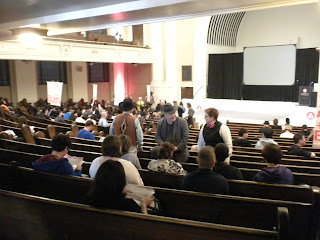The library, for instance, gives students access to some amazing things. There are 152 DVDs from a company called Gnomon, each of which is essentially an Entertainment Design and VFX industry rock star telling you their secrets. These things are pricy to purchase, as DVDs go. I checked out two (the maximum limit) and now I feel like this:
 | |
| Srsly. Bro been jonesin'. |

On the left is the subject. The first stage is "Pentimento," which has a very different meaning in art history than it does in art creation. For artists, the pentimento is a basic blocking in of the shapes. If you look closely at the second image, you can see some crazy geometry in the vase. There are all these triangles, ellipses, a vertical center line, and some dots. These are all tools used in a repeatable, measurable process for drawing accurately from life. Adam, the teacher who ran the workshops, told us that in the Atelier School in Europe, you spend the first six months copying master drawings in a direct 1:1 size ratio, using direct measurement translation. This is an extrapolation of that, which uses measurement of proportions. For example, the short edge of the cylinder is half of its length, and is the same as the edge of the cube. There are many relationships like this, and understanding them is a key point of observation in drawing.
The important message here is that there is no mysterious something, no "X Factor" in the fundamentals of art. All of it is empirical, even scientific, in its method.
After the pentimenti comes blocking in value. Value is how light or dark something is, and we refer to making something darker as "adding value." To do this step, you squint your eyes until you just see two values; light and dark. Then you add some value to the dark bits. This is your starting point. I've started to do it on the second image, and gone past this phase in the third image. The third stage is to find the brightest highlight in your subject, and tone down everything around it in your image. If your brightest highlight is crazy bright in real life, everything else in your image needs to be dark to exhibit the intensity of the highlight.
Once your highlight is taken care of, everything else is just asking yourself if Thing One is brighter, darker, or the same as Thing Two, and adding or erasing value as necessary.
I'd like to reiterate the point that there is no mystery here. This is all measurable. It just takes practice and an understanding of a process. Lastly, I want to show you what that process can do:
This is the result of about seven hours of work. At no point did I feel like I didn't know what to do next. At no point was I without a means of evaluating what could be better or should be different. As I look at it now, I see mistakes, but as prosperity guru PJ Van Hulle would say, mistakes are sexy, because we learn from them. As Mitch Gibson, my drawing instructor, said, "It's good that you're finding your mistakes! That means you get it!"
Well, I'm off to learn from some DVDs, and to try some more new techniques. More to come. Robin out.





